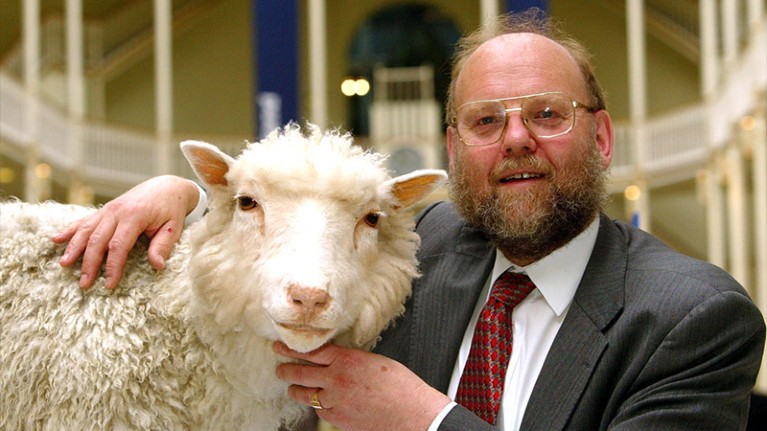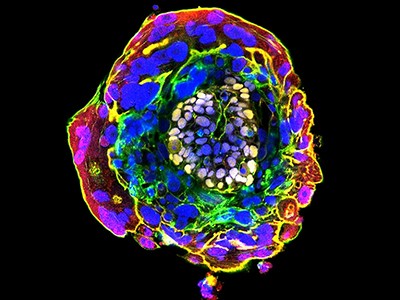
Credit: Maurice McDonald/AP via Alamy
By cloning Dolly the sheep in 1996, embryologist Ian Wilmut rewrote the biological rule book as well as the playbook for science governance. Wilmut was a top-tier scientist whose self-effacing manner helped him to champion the biosciences for a global audience. But he had plenty of help in his endeavours, not least from Dolly herself — one of the world’s most iconic scientific progeny. Wilmut has died, aged 79.
Wilmut’s discovery that viable mammalian offspring could be produced using the nucleus of a differentiated cell blew a huge hole in the idea that genetic instructions were lost when cells committed themselves to specialized pathways. A new theory arose of noisy genetic chit-chat between nuclear DNA and the wider cellular ecosystem. For translational biological and biomedical sciences, the implications were vast. After Dolly, regenerative medicine — the growth of replacement cells and tissues — gained traction as one of the most promising fields of therapeutic development.
How Dolly the sheep's legacy lives on: CRISPR cattle and cloned camels
Born in a village in Warwickshire, UK, Wilmut showed an interest in biology at school and chose to study agriculture at the University of Nottingham, UK, after working on farms as a teenager. He trained in embryology at the Animal Research Station of the University of Cambridge, UK. There his supervisor, Chris Polge, had developed methods of freezing and thawing semen from livestock. Wilmut performed the first successful transfer of a previously frozen embryo into a surrogate heifer, which gave birth in 1973 to Frostie, a healthy bull calf.
Wilmut moved to the Roslin Institute at the University of Edinburgh, UK, in 1973. The experiments that he performed there were daunting and complex. He combined scientific and technical knowledge with clinical and veterinary expertise in an effort that ultimately led to Dolly’s development. Wilmut’s early work on nuclear-transfer techniques led him to consider more efficient ways of producing transgenic animals. A series of cloned lambs followed, including Megan and Morag (from cultured embryonic cells in 1995), and Taffy and Tweed (from cultured fetal cells in 1996).
Cloning a cultured adult cell required an understanding of the role of the cell cycle in the programming of cells. To work, the nucleus had to be transferred from a cell that was in a dormant or ‘quiescent’ state, when it was not dividing. Starting in the mid-1990s, Wilmut and his collaborator Keith Campbell began transferring the nuclei of cultured adult cells that were in this quiescent phase into egg cells that had had their nuclei removed. Dolly was the result of this method — such a feat had previously been considered biologically impossible.
Why researchers should use human embryo models with caution
Dolly’s birth also confirmed that there was a more efficient route for producing large flocks of transgenic sheep that could make therapeutic human proteins in their milk. This was the objective of PPL Therapeutics, the main investment partner in the Dolly project. The company came close to delivering on its goal of generating animals that could produce an enzyme (alpha-1 antitrypsin) that is helpful in fighting lung disease. But it failed in the final stages of developing an effective therapy and was liquidated in the same year that Dolly died, 2004. Despite this, the Dolly project brought invaluable publicity to regenerative biology — mainly owing to the winning combination of Wilmut and his celebrity sheep, which tamed the press with a firm stamp of her hoof. In the face of global calls to ban human cloning, friendly photos of Wilmut and Dolly dampened fears associated with this technology.
Although often shy and reserved, Wilmut became a global spokesperson for science, travelling the world to address governments, speak at conferences and appear on news programmes. He fully grasped the importance of his work. Each time I met him, while researching my own book about Dolly, it was clear that he prioritized the opportunity presented by her birth — and her charm — to win over sceptics and engage curious minds about the benefits of nuclear-transfer techniques. Such methods could be used, for instance, to grow various tissues from scratch.
What is an embryo? Scientists say definition needs to change
In two influential books co-authored with science journalists Colin Tudge and Roger Highfield, Wilmut introduced the concept of the age of biological control. He argued that because it was no longer credible to use the expression ‘biologically impossible’, it was equally meaningless to invoke any idea of natural limitations to scientific discovery. Instead, such limits must be socially engineered, on the basis of legal, ethical and regulatory principles that people could agree on, implement and enforce. The age of biological control, he argued, requires society to set clear limits on scientific endeavours so that researchers can explore unknown paths. This was not an easy message to pitch amid constant political and technological disruption, but, like the tough and steady mountain sheep that Wilmut often encountered on his beloved hill walks, he persevered and his message has changed hearts as, well as minds.
In 2005, Wilmut accepted the position of chair of reproductive science at the University of Edinburgh’s Centre for Regenerative Medicine, where he helped to lead several projects exploring the origins of neurogenerative diseases. He was knighted in 2008 and, in 2012, he retired. In 2018, while continuing to work on neurodegenerative disorders with colleagues at the University of Dundee, UK, Wilmut confirmed that he had Parkinson’s disease. Despite, or perhaps because of, a certain lifelong sheepishness about his contributions, he leaves a legacy of transformed biology and a public willingness to explore biological complexity.

 How Dolly the sheep's legacy lives on: CRISPR cattle and cloned camels
How Dolly the sheep's legacy lives on: CRISPR cattle and cloned camels
 Why researchers should use human embryo models with caution
Why researchers should use human embryo models with caution
 What is an embryo? Scientists say definition needs to change
What is an embryo? Scientists say definition needs to change
 First UK children born using three-person IVF: what scientists want to know
First UK children born using three-person IVF: what scientists want to know
 Cell ‘atlases’ offer unprecedented view of placenta, intestines and kidneys
Cell ‘atlases’ offer unprecedented view of placenta, intestines and kidneys
 Donald D. Brown, groundbreaking embryologist (1931–2023)
Donald D. Brown, groundbreaking embryologist (1931–2023)







